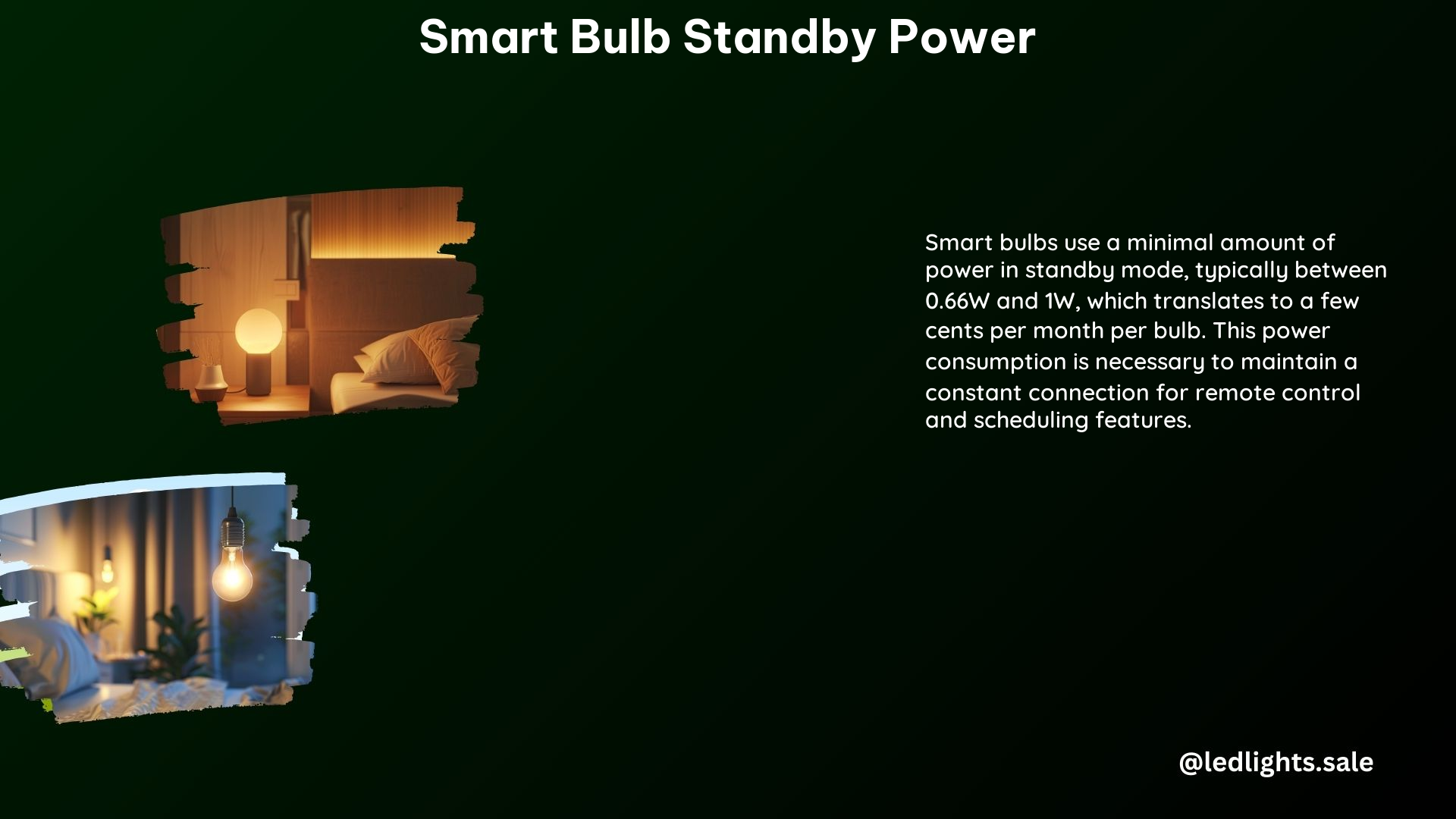Smart bulbs have revolutionized the way we illuminate our homes, offering a wide range of features and benefits. However, one aspect that often raises questions is the power consumption of these bulbs, particularly when they are in standby mode or switched off. This comprehensive guide delves into the intricacies of smart bulb standby power, providing you with the knowledge and tools to optimize your energy usage and minimize the impact on your electricity bills.
Understanding Smart Bulb Standby Power
Smart bulbs, despite their energy-efficient nature, do consume a small amount of power when switched off or in standby mode. This phenomenon is known as “vampire power” or “standby power.” The primary reason for this power consumption is the need to maintain the bulb’s network connectivity (Wi-Fi or Bluetooth) and be ready to receive commands to turn on.
Standby Power Consumption Breakdown
- Smart bulbs typically consume between 0 to 1 watt of power when in standby mode. This power draw is minimal, but it can add up over time, especially if you have multiple smart bulbs in your home.
- For instance, the Philips Hue smart bulb draws between 0 and 0.3 watts in standby mode, which translates to a cost of approximately 1.6 cents per month, assuming an electricity rate of $0.13 per kWh.
- The exact standby power consumption can vary depending on the specific smart bulb model and manufacturer. Some bulbs may have a slightly higher or lower standby power draw.
Factors Affecting Standby Power Consumption
Several factors can influence the standby power consumption of smart bulbs:
- Network Connectivity: Smart bulbs that use Wi-Fi or Bluetooth to connect to your home network will generally consume more power in standby mode compared to those that use a proprietary or low-power wireless protocol.
- Microprocessor and Circuitry: The complexity and design of the smart bulb’s internal microprocessor and supporting circuitry can impact the standby power draw.
- Manufacturer Optimization: Some manufacturers may have implemented power-saving features or optimizations in their smart bulb designs to minimize the standby power consumption.
Comparing Smart Bulbs to Traditional Bulbs

When it comes to energy efficiency, smart bulbs have a significant advantage over traditional incandescent bulbs. This advantage extends beyond just the standby power consumption.
Energy Efficiency and Lifespan
- Smart bulbs, which typically use LED technology, are significantly more energy-efficient than incandescent bulbs. They can use up to 80% less energy when in use.
- Additionally, smart bulbs have a much longer lifespan, ranging from 15,000 to 50,000 hours, compared to the 750 to 2,000 hours of incandescent bulbs.
Cost Savings over Time
The combination of energy efficiency and extended lifespan can lead to substantial cost savings over the lifetime of smart bulbs. While the initial purchase price may be higher, the long-term energy and replacement cost savings can make smart bulbs a more economical choice in the long run.
Minimizing Standby Power Consumption
To further reduce the impact of smart bulb standby power, there are several strategies you can implement:
Utilize Smart Plugs
Consider using smart plugs that allow you to monitor and control the power usage of your smart bulbs remotely. These devices can provide insights into the actual power consumption of your smart bulbs, both in use and in standby mode. Additionally, smart plugs can be programmed to automatically turn off the power to your smart bulbs when they are not in use, effectively eliminating standby power consumption.
Implement Schedules and Automation
Leveraging the scheduling and automation features of your smart bulbs can help reduce their overall energy usage, including standby power consumption. By creating schedules and routines that turn off your smart bulbs when they are not needed, you can minimize the time they spend in standby mode.
Consider Low-Power Wireless Protocols
When selecting smart bulbs, look for models that utilize low-power wireless protocols, such as Zigbee or Z-Wave, instead of Wi-Fi or Bluetooth. These protocols generally consume less power in standby mode, as they are designed for energy-efficient home automation applications.
Monitor and Optimize Energy Usage
Regularly monitor the energy consumption of your smart bulbs, both in use and in standby mode. This can help you identify any outliers or inefficient bulbs and take appropriate actions to optimize their energy usage. Many smart home platforms and apps provide energy monitoring and optimization features to assist with this process.
Conclusion
While smart bulbs do consume a small amount of power in standby mode, the impact on your energy bills is typically negligible. The benefits of smart bulbs, such as their energy efficiency, extended lifespan, and advanced features, often outweigh the minimal standby power consumption. By understanding the specifics of smart bulb standby power and implementing the strategies outlined in this guide, you can effectively minimize the energy usage of your smart lighting system and enjoy the full advantages of this technology.
Reference:
- https://www.aidot.com/blog/post/do-smart-bulbs-use-electricity-when-off
- https://www.livingetc.com/advice/do-smart-light-bulbs-use-electricity-when-off
- https://palmetto.com/home-electrification/how-to-save-money-with-smart-lights
- https://www.reddit.com/r/homeautomation/comments/f7trar/do_bulbs_draw_power_when_switch_is_left_on_but/
- https://chariotenergy.com/chariot-university/do-smart-bulbs-use-power-when-off/
